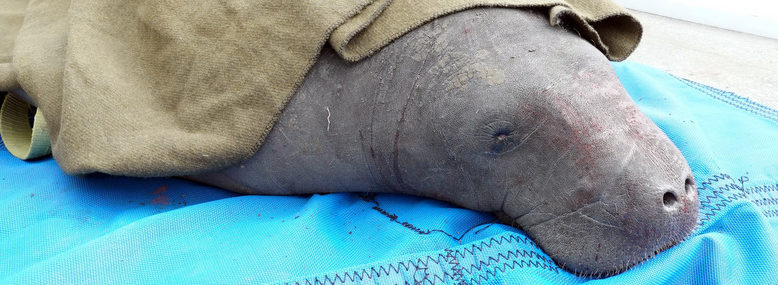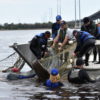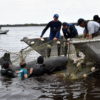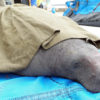Members of the SeaWorld Orlando Rescue Team traveled to Charleston, S.C. recently, where in collaboration with multiple organizations and volunteers – they helped save 10 wayward manatees during the season’s first cold snap.
The manatees were spotted in the upper reaches of the Cooper River, near a warm water outflow area. Historically, manatees move south into warmer waters when the water temperature drops below 68 degrees. Due to rapidly dropping water temperatures in the river, the manatees remained close to the warm water outflow, instead of continuing to travel south. In doing so, they were isolated from adequate food sources and naturally warm waters. Following close coordination with some members of the Manatee Rescue & Rehabilitation Partnership (MRP), U.S. Fish and Wildlife Service (USFWS) staff decided that rescues and relocation of the animals by SeaWorld Orlando’s manatee rescue team were warranted.
In addition to SeaWorld Orlando’s team, support for the rescue effort included USFWS Ecological Services Office staff from Florida and South Carolina, Florida Fish and Wildlife Conservation Commission (FWC) – including staff from St. Petersburg, the Northeast Florida Field Lab in Jacksonville, and the East Central Field Lab in Melbourne along with volunteers and law enforcement, Sea to Shore Alliance, ACE Basin National Wildlife Refuge, Cape Romain National Wildlife Refuge, NOAA National Ocean Services – Charleston, South Carolina Department of Natural Resources (SCDNR), Clearwater (FL) Marine Aquarium, Jacksonville Zoo and Gardens, Pittsburgh Zoo & PPG Aquarium, the University of Florida College of Veterinary Medicine, Charleston County Sheriff’s Office, Brevard Zoo, Brevard County Parks and Recreation, Florida Wildlife Hospital, and Waterfront Solutions. Sea to Shore Alliance and local businesses played an integral role in monitoring the manatees’ activity and condition in the weeks leading up to the rescue effort.
The rescue operation took place over three days. From November 28-30, 2017, the interagency rescue team captured 10 manatees from the Cooper River including eight males and two females. Once captured, each manatee received an immediate health assessment by a veterinary medical team comprised of veterinarians from SeaWorld, Jacksonville Zoo and UF. Manatees were transported south and accompanied on their journey by veterinary and animal care staff. Once in Florida, additional health assessments were conducted at the Jacksonville Zoo by vets from the Zoo and the UF College of Veterinary Medicine. FWC staff served as the lead on transports in Florida to the release site in Brevard County, FL. Nine manatees were deemed releasable. One female was exhibiting mild cold stress and is being cared for by veterinarians and staff at the Jacksonville Zoo with support from SeaWorld and the Lowry Park Zoo. She is Jacksonville Zoo’s first critical care patient at their new facility and is doing well. The Sea to Shore Alliance tagged five of the manatees before release and will monitor these animals as part of their Atlantic Coast manatee study.
Jon Peterson, SeaWorld’s rescue manager, helped with coordination of the multi-agency effort. “It is particularly gratifying to be a part of such a large scale effort, with partners from all over the Southeast lending expertise and manpower,” he explained. “When you can give ten threatened animals another chance at life that is a great week.”
Manatee Rescue & Rehabilitation Partnership
As part of the Manatee Rescue & Rehabilitation Partnership (MRP), SeaWorld Orlando is an acute care rehabilitation facility that provides life-saving medical care to rescued manatees.
The MRP is a cooperative group of non-profit, private, state, and federal entities who work together to monitor the health and survival of rehabilitated and released manatees. Information about manatees currently being tracked is available at www.manateerescue.org. The Florida manatee was recently reclassified from endangered to threatened but is still at risk from both natural and human causes of injury and mortality. Exposure to red tide, cold stress and disease are all natural problems that can affect manatees. Human-caused threats include boat strikes, crushing by floodgates or locks, and entanglement in or ingestion of fishing gear. As part of the Manatee Rescue & Rehabilitation Partnership (MRP), SeaWorld Orlando is an acute care rehabilitation facility that provides life-saving medical care to rescued manatees.
SeaWorld’s Rescue Efforts
Over the last five decades, SeaWorld has rescued more than 31,000 wild animals in need including those that are ill, injured, orphaned or abandoned. SeaWorld’s goal for every rescued animal is to rehabilitate and return them to their natural environment as soon as possible.
This year alone, SeaWorld Orlando has rescued 47 manatees and returned 25 following successful rehabilitation.
Guests to SeaWorld Orlando can learn more about the vital rescue work SeaWorld does for wildlife at the park’s behind-the-scenes Rescue Center used for rehabilitating wildlife that has been ill, injured or orphaned – including manatees, sea turtles, birds and other marine animals.
While a guided tour of the entire facility has been available for years, the park has now opened up one portion of this area for complimentary viewing to all park guests. Visitors are invited to step behind-the-scenes and catch a glimpse of SeaWorld’s working manatee rescue and rehabilitation facility to learn more about the plight of these vulnerable animals in the wild. See firsthand some of the top problems today’s manatee populations are facing and simple actions we can all take to help through digital medical charts, interactive displays, underwater camera viewing and rescue footage straight from the SeaWorld Animal Rescue Team.
For the latest on SeaWorld Orlando and other theme parks, attractions, dining venues and more across the region, be sure to follow Touring Central Florida on twitter @TourCentralFL & @androckb, and give our facebook page a like.




